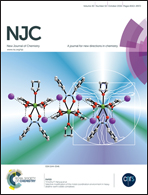[1,2,5]Chalcogenodiazolo[3,4-c]pyridine and selenophene based donor–acceptor–donor electrochromic polymers electrosynthesized from high fluorescent precursors†
Abstract
Conjugated polymers containing selenophene have received attention due to their unique properties and promising application in organic electronics. Herein, to further improve the optoelectronic properties, two typical selenophenes containing [1,2,5]thiadiazolo[3,4-c]pyridine (PT)/[1,2,5]selenadiazolo[3,4-c]pyridine (PS) were synthesized by a donor–acceptor strategy and electropolymerized to form the donor–acceptor–donor polymers. The two precursors exhibited yellow and red emission characteristics with high quantum yields (∼0.48); the value was far greater than those for previously reported selenophenes. Furthermore, electrochromic studies demonstrated that the obtained polymers have superior coloration efficiencies (168 cm−2 C−1) than thiophene based analogues and fast response times (1.6 s).
![Graphical abstract: [1,2,5]Chalcogenodiazolo[3,4-c]pyridine and selenophene based donor–acceptor–donor electrochromic polymers electrosynthesized from high fluorescent precursors](/en/Image/Get?imageInfo.ImageType=GA&imageInfo.ImageIdentifier.ManuscriptID=C5NJ03432A&imageInfo.ImageIdentifier.Year=2016)

 Please wait while we load your content...
Please wait while we load your content...